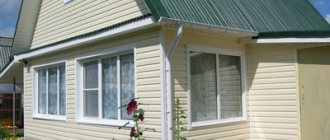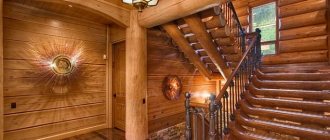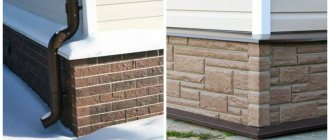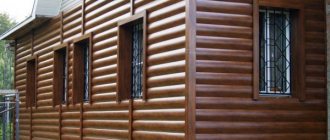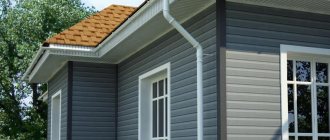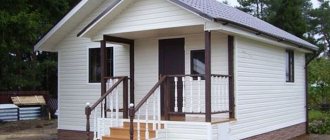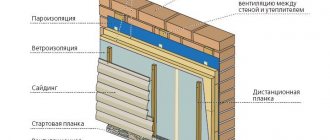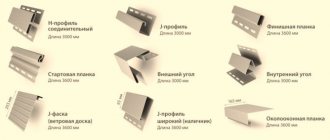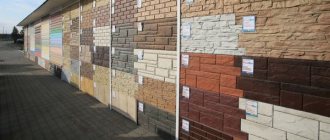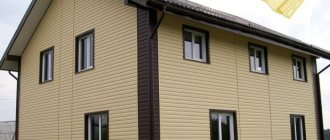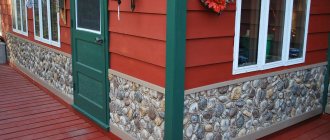Description
The material consists of panels, which subsequently acquire an integral system on the facade of the house. The material used to produce products is varied . Accordingly, each type of siding has its own characteristics and performance characteristics.
There are quite a lot of options for implementing the desired design solution; each type of product has its own color scheme and variety of textures. Basically, the products are characterized by a fairly high level of strength and reliability; they are also profitable to use because their price level is not too high.
Beautiful siding for cladding a house - photo:
Vinyl siding installation tool
Rice. 2. Tools for installing siding
The set of tools that will be required to install the facade can be found in the arsenal of any home craftsman:
- building level, plumb line, corner, cord, pencil - for precise measurements and leveling of the facade;
- a circular electric saw with fine teeth or an angle grinder, scissors and a hacksaw for metal, a cutter for cutting panels;
- screwdriver - for installation work.
You will also need a set of galvanized self-tapping screws with a head of 8 mm or more.
To install siding, you need galvanized self-tapping screws with a head of 8 mm or more.
Advantages and disadvantages
There are a lot of positive characteristics of siding material, the main ones are:
- the period during which siding can be used without problems reaches 50 years;
- Thanks to the finishing with siding panels, the house acquires an attractive appearance . Using this material it is possible to create a variety of styles and realize the most daring design ideas;
- the material does not require special care, there is no need to paint it. It is very easy to handle;
- siding is characterized by lightness and elasticity;
- the process of installing panels is very simple, it requires the efforts of only one person, which allows you to significantly save on a team of workers;
- has high resistance to sudden changes in temperature;
- creates a reliable protective barrier for the surface of the facade of a house finished with siding from the effects of negative destructive environmental phenomena;
- condensation does not form under the surface of the panels, since there are ventilation holes in it that remove accumulated moisture;
- the material is resistant to rotting and corrosion processes, and is also not destroyed due to the activity of insects and microorganisms.
As for the disadvantages of this material, it is worth considering the following points:
- The material from which siding is made is completely synthetic. Accordingly, it does not have a sufficient level of environmental friendliness . This does not apply to the wooden variety of panels, although it is not as reliable as the others.
- Flammability of siding . This point is important in the event of a fire. If the panel begins to melt from the fire, then it releases caustic and toxic substances that are dangerous to the health of people and animals. Stewing products is very difficult.
- If low temperatures persist for a long time, the siding panels become very fragile and may begin to crack . It is even possible for parts of the panel to break off.
- The material is not very resistant to mechanical damage . This is especially important for the metal variety, since for it even a scratch on the surface is a significant threat to quality. The panels cannot be restored, which requires the cost of replacing a damaged panel.
NOTE!
For homes that are exposed to sunlight more often, it's best to choose light-colored siding because it's less prone to fading.
Reasons for the popularity of the material, its features
Due to the fact that siding panels are easy to install and have a low cost, they are popular among our builders. Previously, the cladding of country houses was carried out using only natural materials, but now many other options have appeared on the market.
Wood has become less frequently used as a finishing material, since it has a fairly high price and its own disadvantages that make this material unprofitable compared to other types. Wooden structures are environmentally friendly, but require constant care: periodic painting, replacement of worn parts, repairs. In addition, wood panels are highly flammable and have a limited service life.
As a rule, metal siding is not used for cladding wooden houses. This type of material is used for industrial and other public buildings. The advantages of metal siding were mentioned above, but it has its disadvantages: susceptibility to corrosive processes and large mass.
More recently, basement siding has appeared on the market, which is used to cover the basement in order to additionally protect the building’s foundation from moisture. In its appearance and texture, it resembles finishing using stone or brick. The exterior of a house finished with this material has an aesthetic appearance.
In most cases, vinyl siding is used for cladding. Vinyl panels have a two-layer structure: the first layer is protective, and the second is designed to preserve the physical properties of the material.
But what kind of siding facade design there is can be seen here.
By covering your home with this material, you get:
- durability and long service life up to 50 years;
- the ability not to use additional processing and care products;
- Possibility of installation on any plane;
- there is no risk that undesirable phenomena will occur: rotting and corrosion processes of individual elements of the house.
In addition, siding has strengths:
- decorative material, has a wide variety of colors;
- non-toxic;
- ensures the solidity of the house structure and its protection;
- minimal expenses for its maintenance;
- ease of use (just rinse with water from a hose);
- periodic painting, repair and replacement of parts is not required;
- breathable material, since the panels have holes that provide ventilation and removal of excess moisture;
- protecting your home from exposure to UV rays, rust and putrefactive processes;
- easy to install (any owner can cover a house with siding independently).
But how the façade is covered with siding and how the work is carried out is indicated in this article.
When starting work on decorating a house with this material, you must first make calculations of the required number of panels. This will not be difficult, and you can do everything yourself, focusing on useful information and photos on the Internet.
Kinds
Those who decide to use siding for finishing work on the facade need to familiarize themselves with the varieties of such material.
Highlight:
- Aluminum . It is characterized by a wide range of different reliefs and colors; this variety is intended for finishing office premises or residential type multi-storey buildings. This is explained by the fact that the panels weigh very little, and therefore will not weigh down the facade of a private house.
- Wooden. It consists of wood fibers that are compressed under high temperature conditions with the addition of a special resin. In appearance they imitate natural wood. The price category of such products is quite high. The panels are characterized by flammability.
- Steel . In most cases, this type is used in industrial construction. The color range is quite wide, the product weighs a lot and is prone to corrosion processes.
- Cement. This variety is one of the newest invented by foreign industry. Has a high level of fire resistance . Made from cement and cellulose fibers. In appearance it resembles wooden boards. Well suited for finishing work in educational institutions and kindergartens. It is also gaining popularity in private construction.
- Ceramic. It is also one of the newest inventions. It has its origins in Japan. The price category of the material is low. Siding contains clay and some other natural materials.
- Vinyl. It is considered the most common and popular because it has an affordable cost, a simple installation process, the ability to hide all defects of the facade surface, and is also resistant to moisture and does not support combustion.
- Metal. A type of siding panels that vary in width. Made from steel (galvanized). During production, a polyester coating is applied to the surface of the product, which protects the material from corrosion. The main advantages of this type are a high level of fire resistance, strength and the longest possible service life . Resistant to a wide temperature range.
CAREFULLY!
When choosing aluminum siding for finishing your house, you must take into account that there is a risk of injury during the installation process. This kind of work should be approached as carefully as possible.
Photos of houses covered with siding of different colors:
Siding installation
Let's move on to a direct examination of the rules for attaching vinyl siding to the manufactured sheathing.
Fastening additional elements
Additional elements for installing vinyl siding
- At the base of the building, the height from which the siding will be installed is selected. At the selected level (4 cm above the junction of the facade with the plinth), nails are driven in at the side edges of each wall approximately half the length of the leg. Using twine and chalk, hammer out a straight, even line between the nails.
- The starting bar is mounted along the intended line. It is installed with the top part on the line and carefully attached with nails directly to the surface or to the sheathing. When joining sections of the starting strip for the purpose of lengthening, a gap of 5-6 cm is left between them.
- The plank for the internal corner is mounted at the corresponding junction of the two walls 6 mm below the level of the starting plank. It is nailed to each of the adjacent walls with a nail spacing of 20-40 cm. Like vinyl siding, the planks should not be nailed too tightly. The strips for external corners are mounted in the same way as internal ones.
- For joints with door and window openings, special J-bars are used. They are installed around the perimeter of the joint with the frame and secured with nails.
Installing starter strip for vinyl siding
Advice!
Transverse joining of planks for installation of siding, carried out in the corners of door and window openings, in the corners of walls, etc., is carried out by cutting the corners of the planks at an angle of 45 degrees, followed by alignment at the cut location.
Rules for fastening siding panels
The vinyl siding installation technology provides for the following work procedure:
- The bottom edge of the first siding panel is inserted into the starting strip and the top edge is nailed to the sheathing or wall. The siding is not inserted into the corner strips at the edges of the wall all the way, leaving a gap of 5-10 mm to compensate for possible temperature expansion.
- If the length of the siding is not enough to cover the entire wall, it can be laid in two parts, closing the joint with a special connecting H-bar. The plank is installed perpendicular to the direction of fastening the siding, dividing the wall into two parts (usually in half).
- When the first row of siding is laid and secured, the second is installed. To do this, the lower part of the second panel is inserted into the groove located in the upper part of the first and secured in the same way as the first panel. When joining a panel to a previously installed one, do not pull it towards the joint. Fixed vinyl siding panels should not experience internal stress.
- Following the second panel, all subsequent ones are installed until the entire surface is covered. If necessary, using a cutter or hacksaw, the last panel is cut in width, making a longitudinal cut. Before installing the last siding panel, a finishing strip is installed along the top edge of the wall.
- The last panel is inserted into the groove of the penultimate one and, slightly pulling towards the joint, the upper edge of the last panel is inserted into the groove of the finishing strip. There is no need to nail down the last strip of vinyl siding.
- Installation of siding on the gable part of the building is generally similar, but with minor differences. At the edges of the gable, at the junction with the roof overhang, J-planks are attached at the appropriate angle, and the panels are cut to length not perpendicularly, but at the same angle. The installation itself and joining with the side strips is carried out according to the general rules.
Scheme of fastening various additional elements and vinyl siding panels
Advice!
It is recommended to cut siding panels immediately before installation. And although this process will be more painstaking, trimming the panels at the installation site will reduce the amount of rejected siding to a minimum.
Joining siding panels to each other
You can clearly study the entire procedure described above using the training video attached to this article.
The photo shows the installation of the last siding panel on the gable part of the facade
So, we have described the technology for installing vinyl siding on the facade in every possible detail. We hope that our instructions were not difficult to understand, and you can easily implement them in practice with the required level of quality. Remember that the total price of siding consists not only of the cost of consumables, but also of the cost of installation work. You can significantly reduce the cost of covering your façade with vinyl siding by performing the entire range of installation work yourself.
Finish options
Moving away from the performance characteristics and protective properties of the siding material, it is worth paying attention to the appearance of the building, which will be achieved through the panels. There are a great variety of finishing options, since the range of this material allows any imagination and fantasy to be realized .
In addition to the fact that it is possible to combine several colors of material on the facade of a building, you can purchase panels of different textures and, for example, create an imitation of wood, brick or stone.
Regarding finishing options based on installation technology, there are two of them:
- vertical;
- horizontal.
With the help of vertical installation of siding panels, the facade of the house is visually stretched, the height of the wall becomes visually larger. Horizontal finishing creates a single, holistic system that looks harmonious and cozy.
IMPORTANT!
To create a more expressive and brighter facade of the house, you can use dark-colored siding on the corners of the building.
Finishing a house with siding: preparatory work
Preparing to cover a house with siding begins with cleaning the exterior walls. First of all, all protruding parts that will interfere with the installation of panels are removed: gutters, brackets, ebbs and shutters on windows, trim on doors - everything that sticks out from the flat surface of the walls.
Private houses made of stone and brick are cleaned of old plaster, covering all cracks with cement mortar or polyurethane foam. Wooden houses are cleaned of dirt and mold, and then covered with a layer of antiseptic.
Finishing a house with siding requires an accurate calculation of the required amount of materials. Therefore, it is necessary to measure the width and height of the walls in advance, then subtract the total area of windows and doors from their total area. You also need to calculate the perimeter of the house and all window and door openings, so the total length of the connecting structures will become clear.
Formula for calculating materials:
(area of all walls of the house − area of windows and doors) ÷ area of one panel × 1.10
Only the useful area of the siding panel is taken into account, that is, without the upper fixing part. 1.10 in the formula is a 10% supply of material, which usually goes to waste during inaccurate cutting and final fitting.
It is most convenient to use a schematic house plan - you can use it to calculate the required number of panels piece by piece, and you will immediately see where the full-length panels will go and where trimming will be required. Any siding manufacturer will help you with calculations for free. This can be done in advance in the online services “Alta-calculator” and “Alta-planner”.
Features of care
To maintain the neat appearance of your home, it is necessary to occasionally clean the surface of the siding panels from dirt. If the contamination is insignificant, then it can be easily removed using a strong stream of water . You can use a regular Karcher for this. If more significant dirt appears on the surface, use a soft brush to remove it.
If mold is found on some panels, then after removing it, the panels must be treated with a solution with a 5% concentration of chlorine. It is prohibited to use chlorine in its pure form on panels. You cannot clean the surface if the temperature outside is low.
It is not recommended to use various cleaning products that include abrasive structures, as they can damage the top layer of the material . Chemicals should not be left on the siding surface for more than 10 minutes.
Issues to consider
- How should you screw in the screws?
At a right angle, strictly in the center of the perforation. A gap of 1 mm should be left between the cap and the panel. You can use a nylon washer.
- How much space should be left between siding panels and profiles?
If siding is installed in winter, the gap should be 5-6 mm. In summer – 1-2 mm. Accordingly, in the off-season, 3-4 mm will be enough.
- Is it possible to install siding in winter?
Yes, it can be mounted at temperatures down to -5 degrees. But you will need to cut the panels in a warm room, and after cutting, leave them outside for several hours.
Summary
Rice. 11. Facade covered with vinyl siding
The installation process is simple and straightforward. If you follow the technology, it is quite possible to cover your house with vinyl siding yourself. The only thing is that due to the fact that the panels are long (3 m or more), you need to work in pairs.
If you are not confident in your construction skills, entrust the work to professionals. Siding panels installed in violation of the technology are excluded from the manufacturer's warranty.
Return to list
Material characteristics
Siding is a material that belongs to the types of cladding bases for the facade. Due to it, you can not only protect the facade from destruction from rain, sun, snow, but also give it a more beautiful appearance.
In appearance, these are small panels that are easily connected to each other. For façade cladding, it is placed not end-to-end, but in a herringbone pattern, so moisture does not get inside these seams. This type of finishing first appeared in America in the 19th century. Later, this cladding, due to its beautiful appearance, began to be used for facade decoration in Europe.
Features of cladding wooden and frame houses
External finishing of wooden and frame structures with siding has its own subtleties. Experts recommend starting to cladding a wooden house only after it shrinks. It is best to sheathe the facade using wooden sheathing, having previously treated the slats and the walls themselves with a fungicidal solution. An additional design element is a waterproofing membrane, which is easy to install yourself.
A frame house, the cladding of which uses OSB panels, can be covered with siding without waiting for shrinkage. The house requires installation of wind protection. It is best to do this on top of the OSB, and then lay the insulation. To cover a frame house with siding, you also need sheathing. It is recommended to choose fiber cement siding as cladding.
